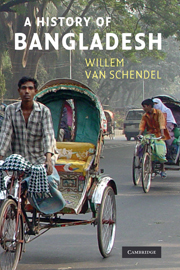Book contents
- Frontmatter
- Contents
- List of plates
- List of maps and figures
- Acknowledgements
- Timeline
- Introduction
- PART I THE LONG VIEW
- PART II COLONIAL ENCOUNTERS
- PART III BECOMING EAST PAKISTAN
- 11 The Pakistan experiment
- 12 Pakistan falls apart
- 13 East Pakistani livelihoods
- 14 The roots of aid dependence
- 15 A new elite and cultural renewal
- PART IV WAR AND THE BIRTH OF BANGLADESH
- PART V INDEPENDENT BANGLADESH
- Conclusion
- Bangladesh district maps
- Key political figures since 1947
- Glossary of Bengali terms
- Notes
- Bibliography
- Index
11 - The Pakistan experiment
Published online by Cambridge University Press: 05 February 2015
- Frontmatter
- Contents
- List of plates
- List of maps and figures
- Acknowledgements
- Timeline
- Introduction
- PART I THE LONG VIEW
- PART II COLONIAL ENCOUNTERS
- PART III BECOMING EAST PAKISTAN
- 11 The Pakistan experiment
- 12 Pakistan falls apart
- 13 East Pakistani livelihoods
- 14 The roots of aid dependence
- 15 A new elite and cultural renewal
- PART IV WAR AND THE BIRTH OF BANGLADESH
- PART V INDEPENDENT BANGLADESH
- Conclusion
- Bangladesh district maps
- Key political figures since 1947
- Glossary of Bengali terms
- Notes
- Bibliography
- Index
Summary
Under its new name – East Pakistan – the Bengal delta now joined a unique experiment in state-making.* There were three reasons why Pakistan was a very special state. First, it was founded upon religious nationalism. Religion was supposed to cement a new national identity, something that had not been tried before – the only other modern example of a religiously based nation-state being Israel, which was founded a year later than Pakistan. Second, Pakistan was a state administering two discrete territories, separated from each other by about 1,500 km of Indian terrain (Map 11.1). West Pakistan was by far the larger of these two wings but East Pakistan was more densely populated. In fact, most Pakistani citizens lived in East Pakistan: the first population census in 1951 revealed that Pakistan had 78 million inhabitants, of whom 44 million (55 per cent) lived in East Pakistan.
These two factors combined with a third: Pakistan did not become heir to any of the colony's central state institutions. India, on the other hand, inherited the capital New Delhi as well as most of the civil bureaucracy, armed forces and police. The bulk of the colony's resources and industries, and its major port cities of Mumbai (Bombay) and Kolkata, also went to India. By contrast, Pakistan inherited largely raw-material producing regions. Whereas the new rulers of India supplanted the British in the old centre of colonial power, the new rulers of Pakistan had a much harder time to establish themselves.
- Type
- Chapter
- Information
- A History of Bangladesh , pp. 107 - 120Publisher: Cambridge University PressPrint publication year: 2009



